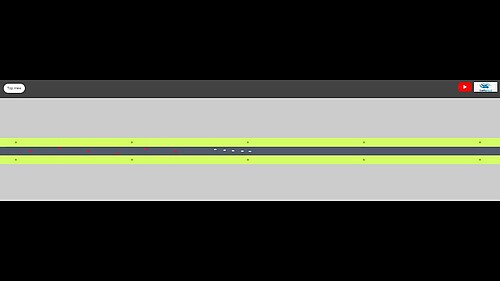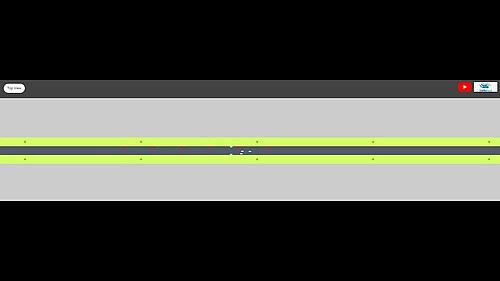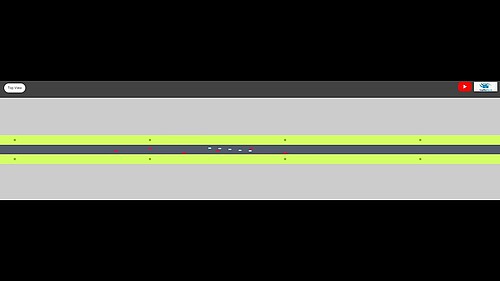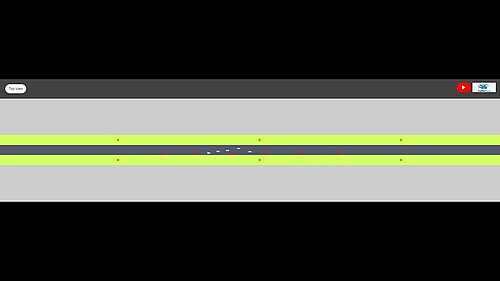Video Playlist 18: Joint vehicle path planning for interruptible 1-D snake-like platoons and 2-D flocks in lane-free traffic
These videos are part of the results presented in the conference papers titled “Joint vehicle path planning for interruptible 1-D snake-like platoons and 2-D flocks in lane-free traffic” and “Joint trajectory planning for 1-D snake-like interruptible vehicle platoons in lane-free traffic”.
For the first paper, two cases, one addressing a platoon of 5 connected and automated vehicles (CAVs) and the other one considering a flock of 5 CAVs, are tested on a lane-free straight road with 15 m width. All the vehicles start from 25 m/s longitudinal speed and try to reach the longitudinal desired speed of 25 m/s and zero lateral speed. In each video, the group faces 6 independent vehicles, acting as moving obstacles whose longitudinal and lateral speeds are kept constant during the whole optimization time horizon. In both videos the camera is tracking the fifth vehicle of the group. Videos are recorded for the whole optimization time horizons and played at 3x speed. At the end of every case, the vehicles have safely overtaken all the obstacles, reached their desired speeds and converged to their desired formations. Movement trajectories are obtained by solving a joint optimal control problem.
Scenario 1
In this video a platoon of 5 vehicles is considered (shown with the color blue), facing 6 obstacles (shown with the color red), that are moving at 20 m/s constant longitudinal speeds and zero lateral speeds. At the start, vehicles are longitudinally located 15 m behind each other. Lateral initial positions of the vehicles are around the center of the road. Each vehicle needs to keep a desired longitudinal distance of 15 m and lateral distance of 0 m from the vehicle in front. In this scenario the platoon moves in a snake-like pattern to avoid collisions with the obstacles. At the end of the video, it can be seen that vehicles have intelligently and safely overtaken all the obstacles while maintaining the desired distances between each other.

Scenario 2
In this video a flock of vehicles is considered (shown with the color blue), facing 6 obstacles (shown with the color red), that are moving at 20 m/s constant longitudinal speeds and with sinusoidal lateral position trajectories. The scenario is challenging as the vehicles first aim at creating a triangle shape, however they need to deform to avoid collisions with the encountered obstacles, after which they again restore their formation. At the end of the video, it can be seen that the vehicles have intelligently overtaken all the obstacles and converged to their triangle-shaped formation.

For the second paper, a platoon of 5 connected and automated vehicles are moving on a lane-free straight road with 14.2 m width. All the vehicles start from 25 m/s longitudinal speed and try to reach the longitudinal desired speed of 25 m/s and zero lateral speed. At the initial state, the 5 vehicles are aligned behind each other in the middle of the road. Each vehicle needs to keep a desired distance of 15 m from the vehicle at front. In each video, the platoon faces 6 independent vehicles, acting as moving obstacles whose longitudinal and lateral speeds are kept constant during the whole optimization time horizon. In both videos the camera is tracking the fifth vehicle of the group. Videos are recorded for the whole optimization time horizons and played at 3x speed. At the end of every scenario, the vehicles have safely overtaken all the obstacles, reached their desired speeds and converged to their desired distances from one another. Joint movement trajectories are obtained by solving an optimal control problem.
Scenario 1
In this video a platoon of 5 vehicles is considered (shown with the color blue), facing 6 obstacles (shown with the color red), that are moving at 20 m/s constant longitudinal speeds and zero lateral speeds. At the start, vehicles are longitudinally located 15 m behind each other. Lateral initial positions of the vehicles are around the center of the road. In this scenario the platoon, moves in a snake-wise pattern to avoid collisions with the obstacles. At the end of the video, it can be seen that vehicles have intelligently and safely overtaken all the obstacles while maintaining the desired distances between each other.

Scenario 2
In this video the same platoon of Scenario 1 is considered (shown with the color blue), facing 6 obstacles (shown with the color red), that are moving at 20 m/s constant longitudinal speeds with sinusoidal lateral position trajectories. This scenario is quite challenging as the platoon is constantly interrupted by the obstacles and the vehicles need to split due to safety reasons and rejoin later. At the end of the video, it can be seen that the vehicles have intelligently overtaken all the obstacles and kept the desired distances between one another.

